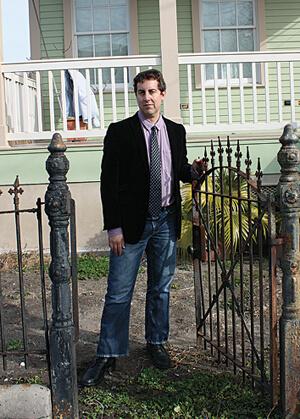Invoking a pot of gumbo in an analogy seems a sure sign that Richard Silverman has naturalized during his three years in New Orleans. A historic architect working with the Federal Emergency Management Agency’s Hazard Mitigation Grant Program, when Silverman considers his work and the broader aesthetic of New Orleans, it goes far beyond bricks and mortar...or weatherboards and wrought iron.
“The most important thing is what we call the tout ensemble. It’s not just an individual piece of architecture; it’s about how the whole thing works together, almost like a big pot of gumbo,” Silverman says. “What makes New Orleans unlike any other city in the United States is that it is not just the architecture — but we have the interplay of the music, the food, and the architecture. We’re trying to retain a way of life here.”
While Silverman hasn’t yet picked up a New Orleans accent, the Memphis native’s soft Tennessee twang suggests the South. In high school, a trip to the White Mountains brought him north and through Burlington. With one look, he was sold that UVM was the college for him. History and historic buildings would begin to take a hold on Silverman during his years on campus. A WRUV DJ, he made it a point to always use the front entrance of Billings Hall, the erstwhile student center, to bask in the H.H. Richardson building’s magnificence.
Professor Sam Hand’s Vermont history class drew Silverman into the past of his surroundings, and he took that interest in another direction with several courses through UVM’s Historic Preservation Program.
“We walked out of the textbook and into the state’s history,” he recalls. “The Champlain Valley was our classroom. We could see eighteenth-century Neo-classical churches, Greek Revival farmhouses, mill buildings along the Winooski — those things you learn about in books, many of them are still there in Vermont. Where else can you do that?”
Silverman would go on to earn master’s degrees in both architecture and architectural history, leading to a sixteen-year career and a wide variety of projects from a building restoration at West Point, New York to the seismic retrofitting of a historic library in Salt Lake City, Utah.
A graduate school internship at the University of Virginia gave Silverman the opportunity to work with a roof restoration at one of America’s most famous homes, Thomas Jefferson’s Monticello. As he describes revealing rafters etched with Roman numerals, Silverman’s passion for the work is plain. “You’re in awe to uncover those things from so long ago. You want to see what the original materials were. How did they put it together? What was on the mind of the architect or builder? What kind of story does it tell?”
Employed by URS Corporation, Silverman works with FEMA on historic architecture issues related to the agency’s $1.79 billion Hazard Mitigation Grant Program. The work carried out through the grant is designed to prepare Louisiana to withstand future disasters. Focused on New Orleans, Silverman oversees the work on historic structures in a city that boasts twenty-five historic districts, the highest concentration in the United States.
“My goal in working with these buildings is to have the lightest touch possible when retrofitting them so that you may not even notice,” Silverman says. “A positive outcome would be for someone to see these buildings years from now and not know that we did this work, but appreciate that they are still here.”
Silverman loves the place and its people — and he makes a pitch to ignore misconceptions, visit, and witness New Orleans’s rise for yourself. For Silverman personally, having a role in the city’s rebirth will likely be the capstone of his career. “To be able to work in the aftermath of Katrina and Rita... I can’t think of a more culturally enriching place to work and see the results of it.”
This article originally appeared in the Spring 2011 issue of Vermont Quarterly magazine. See the entire issue online: alumni.uvm.edu/vq/spring2011. To request a print copy, contact University Communications, (802) 656-2005, newserv@uvm.edu.
